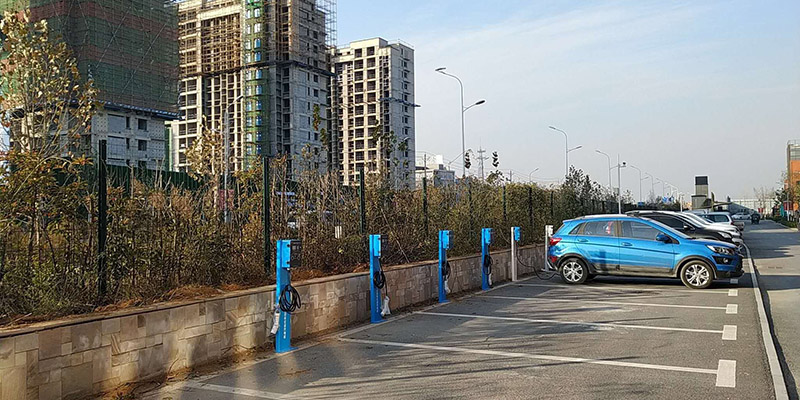![]() AC Charging Pile
AC Charging Pile
![]() DC Charging Pile
DC Charging Pile
2024-01-05
As an essential companion for electric vehicles, the importance of charging stations is self-evident. With the favorable effects of national policies on new energy vehicles, "electric vehicles" have gradually become a hot topic of discussion on the streets and alleys in recent years, and media reports have also emerged one after another. In contrast, the public's attention to "charging stations" is very limited. Don't just think that a charging station is a big "socket", electric cars just need to be connected. In fact, the charging process of electric vehicles is much more complex than that of commonly used household appliances.
First, let's understand the types of charging stations: they can be divided into floor standing charging stations and wall mounted charging stations. Floor standing charging stations are suitable for installation in parking spaces not close to walls. Wall mounted charging stations are suitable for installation in parking spaces close to walls.
According to the installation location, it can be divided into public charging piles and dedicated charging piles. Public charging stations are built in public parking lots combined with parking spaces to provide public charging services for social vehicles. A dedicated charging station is a charging station built in the unit's own parking lot for internal personnel to use. Self use charging stations are built in personal parking spaces to provide charging for private users. Charging stations are generally combined with the construction of parking spaces in parking lots. The protection level of charging stations installed outdoors should not be lower than IP54 (dustproof level 5, waterproof level 4). The protection level of charging piles installed indoors should not be lower than IP32 (dustproof level 3, waterproof level 2) (public charging piles). According to the number of charging interfaces, they can be divided into one pile for one charging and one pile for multiple charging.

How do charging stations charge electric vehicles? Firstly, the user needs to connect the charging gun on the charging station to the electric vehicle for physical connection. After the physical interface between the electric vehicle and the charging station is connected, there must be a handshake protocol between the electric vehicle and the charging station. On the physical layer, first establish the communication protocol standards for both parties. Once both parties have completed communication, the charging station and electric vehicle can recognize each other and start charging. Due to the limited current strength that the batteries inside electric vehicles can withstand, communication between the electric vehicle battery management system and the charging station is also required. After coordinating the appropriate current intensity, the two can be charged. Otherwise, if the current is too high, not only will it cause damage to the car battery, but it may also cause safety issues.
During the charging process, various problems may occur, such as high battery temperature; There is a problem with the power grid, and suddenly there is a surge; If there are problems with the battery management system of charging stations or electric vehicles, and a certain signal does not respond, these problems may lead to risks, and emergency measures need to be taken for various unexpected failures.
When the charging is completed, it is necessary to cut off the power in a timely manner to avoid damage or danger to the battery caused by overcharging. There is also a need for specified communication to send termination signals and to respond to possible faults.
How about charging an electric car, isn't it that simple? The energy of electric vehicle battery packs is enormous, and any deviation can lead to irreversible consequences. Therefore, the design and manufacturing of charging piles have also touched the hearts of the country, new energy enterprises, and users.
In September 2015, the three series of national standards GB/T 20234 "Connection Devices for Conducting Charging of Electric Vehicles" passed the expert review of the Electric Vehicle Sub Technical Committee of the National Technical Committee for Automobile Standardization.
In November 2015, the General Requirements for Conductive Charging Systems of Electric Vehicles and the Communication Protocol between Non onboard Conductive Chargers and Battery Management Systems of Electric Vehicles passed the expert technical review organized by the China Electric Power Enterprise Federation.
These five standards are the revised content of the new national standard for charging station interfaces. All five standards have been reviewed, which means the finalization of the new standard content for charging station interfaces.
Before the introduction of the new national standard, due to the lack of unified national standards, electric vehicles were incompatible with some charging stations, which made charging, which was already inconvenient, even more difficult. Ye Shengji, Deputy Secretary General of the China Association of Automobile Manufacturers, stated that the new standard comprehensively and systematically regulates charging interfaces and communication protocols, providing technical support for the quality assurance system of charging facilities, avoiding disorderly market development, and will play a positive role in promoting the development of new energy vehicles and charging piles.
Next, we will answer the most common questions about charging stations one by one:
Question 1: Does the charging station emit radiation?
In March of this year, Mr. Zhang from Beijing filed a lawsuit against his neighbor Ms. Wang, citing suspicion that she had installed a charging station not far from her home, which posed safety hazards and radiation hazards. He demanded that Ms. Wang remove it.
So does the charging station really have radiation?
Electromagnetic waves in electromagnetic radiation are a form of material existence that has existed around us since ancient times, such as sunlight, lightning, radio waves, infrared, ultraviolet, visible light, etc.
Using an electromagnetic radiation tester to test household appliances, the test results show that the electromagnetic radiation of the laptop is 10.69 μ T. The radiation when watching videos on mobile phones is 18.37 μ T. The CRT television is 2 μ T. LCD TV is 0 μ T. The rear of the hair dryer is 9.32 μ T (body radiation explosion meter), with a terminal block socket of 2.97 μ T. Siemens refrigerator is 0 μ T. The rice cooker is set to 0 μ T. The microwave panel is 19.78 μ T (Positive Radiation Burst Scale).
So what about the radiation from charging stations? The test results show that the electromagnetic radiation during the operation of the charging station is 4.78 μ T. The electromagnetic radiation between the charging gun head and the car charging port is 5.25 μ T. The electromagnetic radiation of BYD e6 is 2.95 μ T. The electromagnetic radiation of Jianghuai iEV4 is 0.597 μ T. And it drops to 0 within 20 centimeters.
The higher the power of an electric vehicle, the greater the electromagnetic radiation. But these radiation values are far lower than the International Health Organization (WHO) and China and Sweden's 100 μ T's electromagnetic radiation warning standard. Therefore, everyone can rest assured about the electromagnetic radiation safety of electric vehicles and charging stations. (Testing provided by Jiangsu Wanbang Dehe New Energy Technology Co., Ltd.)
Question 2: Will charging stations explode?
The news of electric vehicles catching fire and charging station explosions has indeed frightened many people. Ouyang Minggao, Vice Chairman of the China Electric Vehicle Hundred People Association and Professor of Automotive Engineering at Tsinghua University, said that after the charger is combined with the battery, various problems may occur, such as whether it can be charged and to what extent, all of which are instructed by the battery management system. If the quality of the charger is not up to standard, overcharging can easily occur, leading to safety issues.
Ouyang Minggao stated that currently, the new national standard for charging is in a transitional period from old to new. With the increasingly mature technology of charging piles and the gradual implementation and regulatory mechanisms, charging safety will be greatly improved.
Question 3: How to find a charging station?
According to statistics from the Electric Vehicle Charging Infrastructure Promotion Alliance, as of May 2017, member units within the alliance reported a total of 166946 public charging piles, including 59597 AC charging piles, 41275 DC charging piles, and 66074 AC DC integrated charging piles; There are 126152 private charging stations built by car companies.
Why are there so many charging stations that seem like they can't be found in actual use?
Dr. Li Qiushuo from the Southern Power Grid Research Institute stated that the growing demand for charging and the shortage of land have become a prominent contradiction. At present, there is no land or space to build charging stations in the urban center and areas with high traffic volume; Relying on the construction of existing parking lots involves communication and coordination with parking lots and property management, making communication and coordination difficult. In addition, it is necessary to strengthen charging guidance through information technology to avoid situations where users cannot find a charging station when they need to charge.
At present, multiple companies in the market have launched mobile app pile finding software, such as the "Dudu Charging" app developed and operated by Southern Power Grid Comprehensive Energy Co., Ltd. Users can use it to search for charging piles, make appointments for charging, and pay online anytime and anywhere. Up to now, "Dudu Charging" has been connected to more than 1800 charging stations in 175 cities across 27 provinces in China, with nearly 10000 charging stations and a charging capacity of over 3.2 million kilowatt hours.
(Based on the degree charging platform, the Southern Power Grid Electric Vehicle Charging Operation Monitoring Center can achieve real-time monitoring of the operation status of multi-level charging facilities in provinces, cities, and regions around the clock.)
The outbreak of the new energy vehicle industry directly drives the development of charging pile supporting facilities.
From historical data, before 2013, both new energy vehicles and charging stations were in the introduction period, and their development was relatively balanced under government planning, with a vehicle to station ratio maintained at around 1.
Since 2014, new energy vehicles have taken the lead in achieving large-scale development, with a year-on-year increase of three times. The growth rate of new energy vehicles has far exceeded the development speed of charging piles, and the imbalance between vehicles and piles has reached over 4.
(The above data is sourced from the "Research Report on Development Strategies and Prospects of China's Charging Pile Industry during the 13th Five Year Plan from 2016 to 2022")
Dr. Li Qiushuo from the Southern Power Grid Research Institute stated that in order to promote the construction of charging infrastructure, the country has adopted a series of support and subsidy policies. From the data, from June 2016 to May 2017, there were approximately 7443 new public charging facilities added per month, with a year-on-year increase of 115% in May 2017. However, the current subsidy policy can easily lead to blind construction, idle charging stations, resource waste, and other phenomena. The healthy and orderly development of charging stations still has a long way to go.
wechat:18038169304
